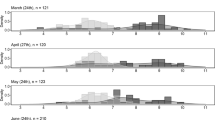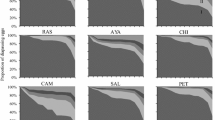Abstract
Phenotypic plasticity in life history traits favors the establishment of invaders and may magnify their ecological impacts. Pomacea canaliculata, the only freshwater snail listed among the 100 worst invaders worldwide, is able to complete its life cycle within a wide range of conditions, a capacity attributed to its life history plasticity. Using snails from their native range in Argentina we investigated the changes in fecundity, egg mass traits, offspring quality, and efficiency of food conversion into eggs in response to different levels of food availability throughout different life stages. Pre-maturity mortality was not affected by chronic reductions of up to 80% in food availability. Females fed ad libitum demonstrated no significant reproductive output differences when mated with males raised at different food availability levels. For females, the number and total weight of eggs and the size of egg masses decreased at high levels of food deprivation. Their efficiency of conversion into eggs of the food ingested during the reproductive period increased with deprivation, as did the survival time of their offspring. In contrast, the egg mass laying rate and the individual egg weight did not differ under different food availability regimes. Reductions in food availability have been suggested as a control method but our results indicate that fecundity would be lessened only at deprivation levels higher than 50% and would be partially compensated by an increase in hatchling survival.




Similar content being viewed by others
References
Albrecht EA, Carreño NB, Castro-Vazquez A (1996) A quantitative study of copulation and spawning in the South American apple-snail, Pomacea canaliculata (Prosobranchia: Ampullariidae). Veliger 39:142–147
Barnes M, Fordham R, Burks R, Hand JJ (2008) Fecundity of the exotic apple snail, Pomacea insularum. J N Am Benthol Soc 27:738–745
Burela S, Martín PR (2009) Sequential pathways in the mating behavior of the apple snail Pomacea canaliculata (Caenogastropoda: Ampullariidae). Malacologia 51:157–164
Burela S, Martín PR (2011) Evolutionary and functional significance of lengthy copulations in a promiscuous apple snail, Pomacea canaliculata (Caenogastropoda: Ampullariidae). J Mollus Stud 77:54–64
Burks RL, Kyle CH, Trawick MK (2010) Pink eggs and snails: field oviposition patterns indicate shallow aquatic systems susceptible to invasion by Pomacea insularum. Hydrobiologia 646:243–251
Carlsson NOL, Brönmark C, Hansson L-A (2004) Invading herbivory: the golden apple snail alters ecosystem functioning in Asian wetlands. Ecology 85:1575–1580
Caswell H (1983) Phenotypic plasticity in life-history traits: demographic effects and evolutionary consequences. Am Zool 23:35–46
Cazzaniga NJ, Estebenet AL (1984) Revisión y notas sobre los hábitos alimentarios de los Ampullariidae (Gastropoda). Historia Natural 4:213–224
Chevin L-M, Lande R, Mace GM (2010) Adaptation, plasticity, and extinction in a changing environment: towards a predictive theory. PLoS Biol 8(4):e1000357. doi:10.1371/journal.pbio.1000357
Cowie RH (2002) Apple snails (Ampullariidae) as agricultural pests: their biology, impacts and management. In: Barker GM (ed) Molluscs as Crop Pests. CABI Publishing, Wallingford, pp 145–192
Estebenet AL (1995) Food and feeding in Pomacea canaliculata (Gastropoda; Ampullariidae). Veliger 38:277–283
Estebenet AL, Cazzaniga NJ (1992) Growth and demography of Pomacea canaliculata (Gastropoda: ampullariidae) under laboratory conditions. Malacol Rev 25:1–12
Estebenet AL, Cazzaniga NJ (1993) Egg variability and the reproductive strategy of Pomacea canaliculata (Gastropoda: Ampullariidae). Apex 8:129–138
Estebenet AL, Martín PR (2002) Pomacea canaliculata (Gastropoda: Ampullariidae): life-history traits and their plasticity. Biocell 26:83–89
Estebenet AL, Martín PR, Burela S (2006) Conchological variation in Pomacea canaliculata and other South American Ampullariidae (Caenogastropoda, Architaenioglossa). Biocell 30:329–335
Estoy GF, Yusa Y, Wada T, Sakurai H, Tsuchida K (2002a) Size and age at first copulation and spawning of the apple snail, Pomacea canaliculata (Gastropoda: Ampullariidae). Appl Entomol Zool 37:199–206
Estoy GF, Yusa Y, Wada T, Sakurai H, Tsuchida K (2002b) Effect of food availability and age on the reproductive effort of the apple snail, Pomacea canaliculata (Gastropoda: Ampullariidae). Appl Entomol Zool 37:543–550
Gotthard K, Nylin S (1995) Adaptive plasticity and plasticity as an adaptation: a selective review of plasticity in animal morphology and life history. Oikos 74:3–17
Guo O (2006) Intercontinental biotic invasions: what can we learn from native populations and habitats? Biol Invasions 8:1451–1459
Hänfling B, Kollmann J (2002) An evolutionary perspective of biological invasions. Trends Ecol Evol 17:545–546
Hayes KA, Joshi RC, Thiengo SC, Cowie RH (2008) Out of South America: multiple origins of non-native apple snails in Asia. Divers Distrib 14:701–712
Heras H, Garín C, Pollero R (1998) Biochemical composition and energy source during embryo development and in early juveniles of the snail Pomacea canaliculata (Mollusca: Gastropoda). J Exp Zool 280:375–383
Heras H, Dreon MS, Ituarte S, Pollero RJ (2007) Egg carotenoproteins in neotropical Ampullariidae (Gastropoda: Arquitaenioglossa). Comp Biochem Physiol C Toxicol Pharmacol 146:158–167
Horn KC, Johnson SD, Boles KM, Moore A, Siemann E, Gabler CA (2008) Factors affecting hatching success of golden apple snail eggs: effects of water immersion and cannibalism. Wetlands 28:544–549
Jackson D, Jackson D (2009) Registro de Pomacea canaliculata (Lamarck, 1822) (Ampullariidae), molusco exótico para el norte de chile. Gayana 73:40–44
Jerde CL, Bampfylde CJ, Lewis MA (2009) Chance establishment for sexual, semelparous species: overcoming the Allee effect. Am Nat 173:734–746
Joshi RC, Sebastian LS (2006) Global advances in ecology and management of golden apple snails. Philippine Rice Research Institute, Nueva Ecija
Keller RP, Drake JM, Lodge DM (2007) Fecundity as a basis for risk assessment of nonindigenous freshwater molluscs. Conserv Biol 21:191–200
Koch E, Winik BC, Castro-Vazquez A (2009) Development beyond the gastrula stage and digestive organogenesis in the apple-snail Pomacea canaliculata (Architaenioglossa, Ampullariidae). Biocell 33:49–65
Kwong KL, Dudgeon D, Wong PK, Qiu JW (2009) Secondary production and diet of an invasive snail in freshwater wetlands: implications for resource utilization and competition. Biol Invasions 12:1153–1164
Lach L, Britton DK, Rundell R, Cowie RH (2000) Food preference and reproductive plasticity in an invasive freshwater snail. Biol Invasions 2:279–288
Letelier S, Soto-Acuña S (2008) Registro de Pomacea sp. en Chile. Amici Molluscarum 16:6–13
López MA, Altaba CR, Andree KB, López V (2010) First invasion of the apple snail Pomacea insularum in Europe. Tentacle 18:26–28
Lowe S, Browne M, Boudjelas S, De Poorter M (2000) 100 of the world’s worst invasive alien species. The Invasive Species Specialist Group, IUCN, Auckland
Lv S, Zhang Y, Liu HX, Hu L, Yang K, Steinmann P, Chen Z, Zhou X-N (2009) Invasive snails and an emerging infectious disease: results from the first national survey on Angiostrongylus cantonensis in China. PLoS Neglect Trop Dis 3(2):e368. doi:10.1371/journal.pntd.0000368
Martín PR, Estebenet AL (2002) Interpopulation variation in life-history traits of Pomacea canaliculata (Gastropoda: Ampullariidae) in southwestern Buenos Aires Province, Argentina. Malacologia 44:153–163
Mousseau TA, Fox CW (1998) The adaptive significance of maternal effects. Trends Ecol Evol 13:403–407
Pizani N, Estebenet AL, Martín PR (2005) Effects of submersion and aerial exposure on clutches and hatchlings of Pomacea canaliculata (Gastropoda: Ampullariidae). Am Malacol Bull 20:55–63
Plaistow SJ, Lapsley CT, Beckerman AP, Benton TG (2004) Age and size at maturity: sex, environmental variability and developmental thresholds. Proc R Soc B-Biol Sci 271:919–924
Qiu JW, Kwong KL (2009) Effects of macrophytes on feeding and life-history traits of the invasive apple snail Pomacea canaliculata. Freshwater Biol 54:1720–1730
Rawlings TA, Hayes KA, Cowie RH, Collins TM (2007) The identity, distribution, and impacts of non-native apple snails in the continental United States. BMC Evol Biol 7:97
Seigel RA, Ford NB (2001) Phenotypic plasticity in reproductive traits: geographical variation in plasticity in a viviparous snake. Funct Ecol 15:36–42
Seuffert ME, Martín PR (2010) Dependence on aerial respiration and its influence on microdistribution in the invasive freshwater snail Pomacea canaliculata (Caenogastropoda, Ampullariidae). Biol Invasions 12:1695–1708
Seuffert ME, Burela S, Martín PR (2010) Influence of water temperature on the activity fo the freshwater snail Pomacea canaliculata (Caenogastropoda: Ampullariidae) at its southernmost limit (Southern Pampas, Argentina). J Therm Biol 35:77–84
Stearns SC (1992) The evolution of life histories. Oxford University Press, Oxford
Takeda N (1999) Histological studies on the maturation of the reproductive system in the apple snail, Pomacea canaliculata. J Anal Biosciences 22:425–432
Tamburi NE, Martín PR (2009a) Reaction norms of size and age at maturity of Pomacea canaliculata (Gastropoda: Ampullariidae) under a gradient of food deprivation. J Mollus Stud 75:19–26
Tamburi NE, Martín PR (2009b) Feeding rates and food conversion efficiencies in the apple snail Pomacea canaliculata (Caenogastropoda: Ampullariidae). Malacologia 51:221–232
Tanaka K, Watanabe T, Higuchi H, Miyamoto K, Yusa Y, Kiyonaga T, Kiyota H, Suzuki Y, Wada T (1999) Density dependent growth and reproduction of the apple snail, Pomacea canaliculata: a density manipulation experiment in a paddy field. Res Popul Ecol 41:253–262
Terra NR, Schäfer A (1999) Weight gain and reproduction of Pomacea canaliculata (Lamarck, 1822) (Gastropoda: Ampullariidae). Brazilian J Ecol 3:12
Turner LR (1998) Effects of submergence on embryonic survival and developmental rate of the Florida Applesnail, Pomacea paludosa; implications for egg predation and marsh management. Florida Scientist 61:118–129
Valiente AG, Juanes F, Nuñez P, Garcia-Vazquez E (2010) Brown trout (Salmo trutta) invasiveness: plasticity in life-history is more important than genetic variability. Biol Invasions 12:451–462
Van Der Sman J, Phillips NE, Pfister CA (2009) Relative effects of maternal and juvenile food availability for a marine snail. Ecology 90:3119–3125
Whitman DW, Agrawal AA (2009) What is Phenotypic Plasticity and why is it Important? In: Whitman DW, Ananthakrishna TN (eds) Phenotypic plasticity of insects: mechanisms and consequences. Science Publishers, Inc, Enfield, NH, pp 1–63
Wilson EE, Mullen LM, Holway DA (2009) Life history plasticity magnifies the ecological effects of a social wasp invasion. P Natl Acad Sci USA 106:12809–12813
Wood TS, Anurakpongsatorn P, Chaichana R, Mahujchariyawong J, Satapanajaru T (2006) Heavy predation on freshwater bryozoans by the golden apple snail, Pomacea canaliculata Lamarck, 1822 (Ampullariidae). Nat Hist J Chulalongkorn Univ 6:31–36
Yoshida K, Hoshikawa K, Wada T, Yusa Y (2009) Life cycle of the apple snail Pomacea canaliculata (Caenogastropoda: Ampullariidae) inhabiting Japanese paddy fields. Appl Entomol Zool 44:465–474
Acknowledgments
This work was funded with grants by Consejo Nacional de Investigaciones Científicas y Técnicas (CONICET; PIP 6150) and Universidad Nacional del Sur (PGI 24/B144). NET is a postdoctoral fellow and PRM a researcher in CONICET. We wish to thank two anonymous reviewers and Associate Editor R. Cowie for their useful comments.
Author information
Authors and Affiliations
Corresponding author
Rights and permissions
About this article
Cite this article
Tamburi, N.E., Martín, P.R. Effects of food availability on reproductive output, offspring quality and reproductive efficiency in the apple snail Pomacea canaliculata . Biol Invasions 13, 2351–2360 (2011). https://doi.org/10.1007/s10530-011-0047-2
Received:
Accepted:
Published:
Issue Date:
DOI: https://doi.org/10.1007/s10530-011-0047-2




